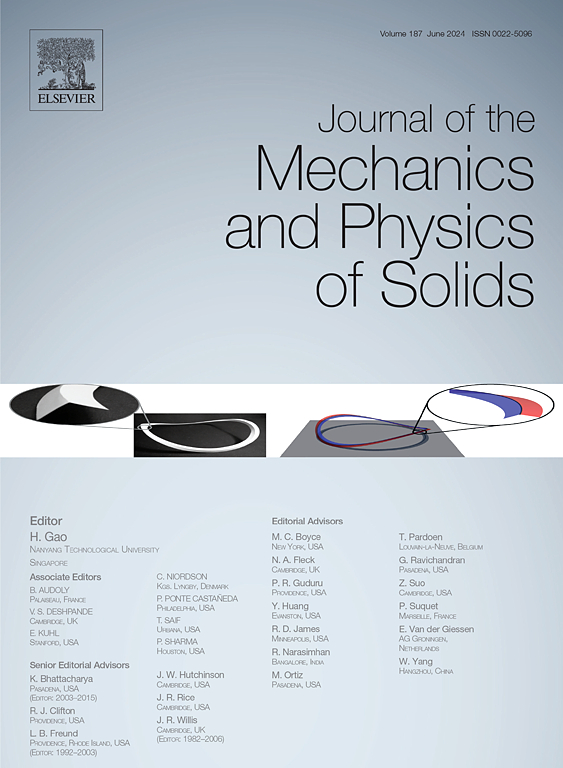形状记忆合金转化-塑性耦合晶体力学模型的隐式实施,包括转化旋转
IF 5
2区 工程技术
Q2 MATERIALS SCIENCE, MULTIDISCIPLINARY
引用次数: 0
摘要
本文提出了一种与速率相关的晶体塑性(CP)框架,该框架可捕捉形状记忆合金(SMA)的相变-塑性变形耦合行为。与以前的模型不同,这里的马氏体相变流动规则包含了相变的整个变形梯度,包括旋转。使用该模型对镍钛合金(NiTi)的转变应变和变体选择进行的预测,与之前不包含旋转的公式进行了直接比较。结果表明,旋转对于准确计算 SMA 变体选择和转化应变的单晶和多晶微观力学至关重要。构成法公式还包括滑移和变形孪生塑性机制的当前公式,并进一步表明转化机制的差异会通过转化-塑性相互作用影响塑性计算。除了构造定律的进步之外,还给出了一种计算效率高的隐式时间积分方案,用于数值实施,并使用商业有限元代码 ABAQUS Standard 中的用户材料子程序 (UMAT) 进行了演示。在模拟非弹性变形时,所提出的框架和相关的数值协议可在应变增量为 0.05 mm/mm 和在弹性-非弹性转换时应变增量为 0.01 mm/mm 的情况下获得稳定的解决方案。此外,在计算弹性-非弹性转换的解时,使用解析雅各布因子可在不到 10 次全局牛顿迭代中实现稳定收敛,计算优势显而易见。本文章由计算机程序翻译,如有差异,请以英文原文为准。
Implicit implementation of a coupled transformation – plasticity crystal mechanics model for shape memory alloys that includes transformation rotations
A rate-dependent crystal-plasticity (CP) framework that captures the coupled phase transformation - plastic deformation behavior of shape memory alloys (SMAs) is presented. Here, different from previous models, the flow rule for martensitic phase transformation incorporates the entire deformation gradient for transformation, including the rotation. Predictions of transformation strain and variant selection of Nickel-Titanium (NiTi) using this model are directly compared with previous formulations that did not include the rotation. The results show that the rotation is essential to accurately calculate the single crystal and polycrystal micromechanics of variant selection and transformation strains of SMAs. The constitutive law formulation also includes current formulations for both slip and deformation twinning plasticity mechanisms, and the differences in transformation mechanisms are further shown to impact plasticity calculations through transformation-plasticity interactions. In addition to the advancement of the constitutive law, a computationally efficient implicit time integration scheme is given for numerical implementation and demonstrated using a user material subroutine (UMAT) in the commercial finite element code ABAQUS Standard. The proposed framework and the associated numerical protocols achieve stable solutions using strain increments on the order of mm/mm in simulating inelastic deformations and strain increments mm/mm in the elastic-inelastic transitions. Furthermore, the use of an analytic Jacobian results in stable convergence in fewer than 10 global Newton iterations while calculating solutions for elastic-inelastic transitions, making the computational benefits evident.
求助全文
通过发布文献求助,成功后即可免费获取论文全文。
去求助
来源期刊
CiteScore
9.80
自引率
9.40%
发文量
276
审稿时长
52 days
期刊介绍:
The aim of Journal of The Mechanics and Physics of Solids is to publish research of the highest quality and of lasting significance on the mechanics of solids. The scope is broad, from fundamental concepts in mechanics to the analysis of novel phenomena and applications. Solids are interpreted broadly to include both hard and soft materials as well as natural and synthetic structures. The approach can be theoretical, experimental or computational.This research activity sits within engineering science and the allied areas of applied mathematics, materials science, bio-mechanics, applied physics, and geophysics.
The Journal was founded in 1952 by Rodney Hill, who was its Editor-in-Chief until 1968. The topics of interest to the Journal evolve with developments in the subject but its basic ethos remains the same: to publish research of the highest quality relating to the mechanics of solids. Thus, emphasis is placed on the development of fundamental concepts of mechanics and novel applications of these concepts based on theoretical, experimental or computational approaches, drawing upon the various branches of engineering science and the allied areas within applied mathematics, materials science, structural engineering, applied physics, and geophysics.
The main purpose of the Journal is to foster scientific understanding of the processes of deformation and mechanical failure of all solid materials, both technological and natural, and the connections between these processes and their underlying physical mechanisms. In this sense, the content of the Journal should reflect the current state of the discipline in analysis, experimental observation, and numerical simulation. In the interest of achieving this goal, authors are encouraged to consider the significance of their contributions for the field of mechanics and the implications of their results, in addition to describing the details of their work.

 求助内容:
求助内容: 应助结果提醒方式:
应助结果提醒方式:


